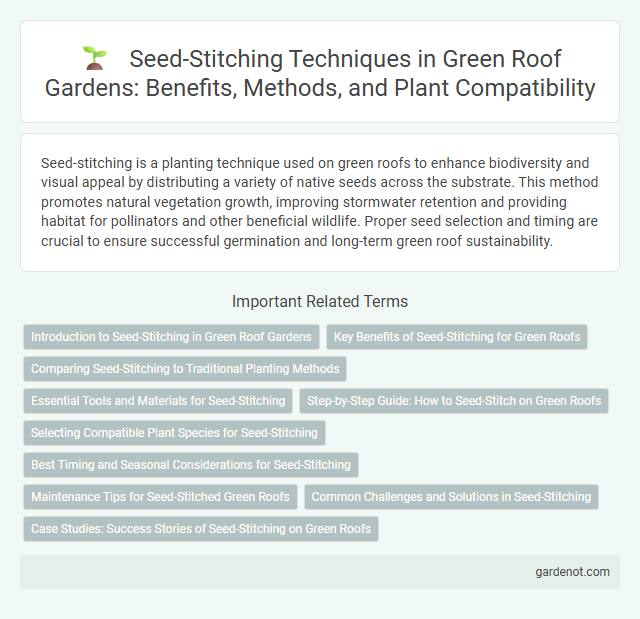Seed-stitching is a planting technique used on green roofs to enhance biodiversity and visual appeal by distributing a variety of native seeds across the substrate. This method promotes natural vegetation growth, improving stormwater retention and providing habitat for pollinators and other beneficial wildlife. Proper seed selection and timing are crucial to ensure successful germination and long-term green roof sustainability.
Introduction to Seed-Stitching in Green Roof Gardens
Seed-stitching in green roof gardens involves strategically dispersing native plant seeds directly onto the growing medium to promote natural vegetation establishment. This technique enhances biodiversity by supporting a variety of drought-tolerant and low-maintenance plants adapted to rooftop microclimates. Utilizing seed-stitching reduces the need for mature plant installation, lowering costs while fostering a sustainable and resilient green roof ecosystem.
Key Benefits of Seed-Stitching for Green Roofs
Seed-stitching enhances green roofs by promoting rapid and uniform vegetation establishment, which improves erosion control and biodiversity. This technique increases plant density and root development, leading to better stormwater retention and thermal insulation. Improved plant coverage reduces maintenance costs and extends the lifespan of the green roof system.
Comparing Seed-Stitching to Traditional Planting Methods
Seed-stitching enhances green roof establishment by dispersing native wildflower seeds directly into the substrate, promoting rapid germination and diverse plant coverage compared to traditional plug or sod planting. Unlike conventional methods that involve transplanting mature plants, seed-stitching reduces installation costs and minimizes plant shock, leading to higher survival rates under extreme rooftop conditions. This technique supports greater biodiversity and ecosystem resilience, optimizing green roof performance in stormwater management and urban heat mitigation.
Essential Tools and Materials for Seed-Stitching
Seed-stitching on a green roof requires essential tools such as a seed spreader or handheld scoop for precise seed placement, a lightweight rake to gently cover seeds with soil, and a moisture meter to monitor hydration levels. High-quality seeds suited for the local climate and substrate type are critical for successful germination and growth. Protective materials like biodegradable seed mats or erosion control blankets help stabilize seeds during establishment and ensure optimal growth conditions.
Step-by-Step Guide: How to Seed-Stitch on Green Roofs
Seed-stitching on green roofs involves strategically planting individual seeds or small seed clusters into prepared substrates to enhance vegetation density and diversity. Begin by selecting appropriate native or drought-tolerant seed varieties, ensuring they match the microclimate and soil conditions of the roof. Prepare the substrate by lightly raking and moistening the surface, then carefully place seeds at recommended spacing intervals before gently pressing them into the soil to improve contact and germination rates.
Selecting Compatible Plant Species for Seed-Stitching
Selecting compatible plant species for seed-stitching on green roofs involves prioritizing drought-tolerant, shallow-rooted varieties such as sedums, native grasses, and wildflowers that thrive in the local climate. These species ensure enhanced soil stability, improved water retention, and biodiversity support while minimizing maintenance needs. Emphasizing native and adaptive plants increases the success rate of seed-stitching by promoting resilience against harsh rooftop conditions and varying microclimates.
Best Timing and Seasonal Considerations for Seed-Stitching
Seed-stitching a green roof is best done during early spring or fall when temperatures are moderate, promoting optimal seed germination and root establishment. Seasonal considerations include avoiding summer heat and winter frost, which can stress young seedlings and hinder growth. Moisture availability also plays a crucial role, making periods with consistent rainfall ideal for successful seed-stitching.
Maintenance Tips for Seed-Stitched Green Roofs
Seed-stitching on green roofs enhances vegetation density by filling bare patches with targeted seed placement, promoting uniform plant coverage and reducing erosion. Regular irrigation ensures optimal germination, while periodic monitoring for weed intrusion and pest activity maintains plant health and roof integrity. Seasonal fertilization tailored to the plant species supports vigorous growth and long-term sustainability of seed-stitched green roof systems.
Common Challenges and Solutions in Seed-Stitching
Seed-stitching on green roofs often encounters challenges such as unpredictable seed germination rates, soil erosion, and inconsistent water retention. To overcome these issues, the use of biodegradable mats and hydroseeding techniques improves seed stabilization and moisture distribution. Selecting native, drought-tolerant plant species enhances resilience and reduces maintenance requirements for effective seed-stitching success.
Case Studies: Success Stories of Seed-Stitching on Green Roofs
Case studies on seed-stitching reveal significant success in enhancing green roof biodiversity and vegetation density, particularly in urban environments. Projects in cities like Chicago and Toronto demonstrate improved plant establishment and reduced maintenance costs by strategically placing native seed clusters on modular green roof trays. These successes underscore seed-stitching as a cost-effective method for promoting ecological benefits and resilience in green roof systems.
Seed-stitching Infographic

 gardenot.com
gardenot.com